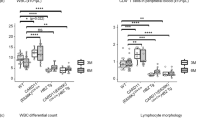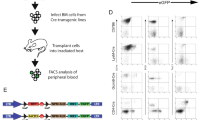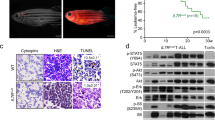Abstract
Chronic myelogenous leukemia (CML) is a hematopoietic disorder, which begins as indolent chronic phase but inevitably progresses to fatal blast crisis. p210BCR/ABL, a constitutively active tyrosine kinase, is responsible for disease initiation but molecular mechanism(s) underlying disease evolution remains largely unknown. To explore this process, we employed retroviral insertional mutagenesis to CML-exhibiting p210BCR/ABL transgenic mice (Tg). Virus infection induced acute lymphoblastic leukemia (ALL) in p210BCR/ABL Tg with a higher frequency and in a shorter latency than wild-type littermates, and inverse PCR detected two retrovirus common integration sites (CISs) in p210BCR/ABL Tg tumors. Interestingly, one CIS was the transgene itself, where retrovirus integrations induced upregulation of p210BCR/ABL and production of truncated BCR/ABL with an enhanced kinase activity. Another CIS was Notch1 gene, where retrovirus integrations resulted in overexpression of Notch1 and generation of Notch1 lacking the C-terminal region (Notch1ΔC) associated with stable expression of its activated product, C-terminal-truncated Notch intracellular domain (NICDΔC). In addition, generation of Tg for both p210BCR/ABL and Notch1ΔC developed ALL in a shortened period with Stat5 activation, demonstrating the cooperative oncogenicity of Notch1ΔC/NICDΔC with p210BCR/ABL involving Stat5-mediated pathway. These results demonstrated that overexpression/enhanced kinase activity of BCR/ABL and altered expression of Notch1 induces acute leukemia in a transgenic model for CML.
This is a preview of subscription content, access via your institution
Access options
Subscribe to this journal
Receive 50 print issues and online access
$259.00 per year
only $5.18 per issue
Buy this article
- Purchase on Springer Link
- Instant access to full article PDF
Prices may be subject to local taxes which are calculated during checkout





Similar content being viewed by others
References
Abraham KM, Levin SD, Marth JD, Forbush KA, Perlmutter RM . (1991). Thymic tumorigenesis induced by overexpression of p56lck. Proc Natl Acad Sci USA 88: 3977–3981.
Akagi K, Suzuki T, Stephens RM, Jenkins NA, Copeland NG . (2004). RTCGD: retroviral tagged cancer gene database. Nucleic Acids Res 32 (Database issue): D523–D527.
Bray SJ . (2006). Notch signalling: a simple pathway becomes complex. Nat Rev Mol Cell Biol 7: 678–689.
Calabretta B, Perrotti D . (2004). The biology of CML blast crisis. Blood 103: 4010–4022.
Deininger MWN, Goldman JM, Melo JV . (2000). The molecular biology of chronic myeloid leukemia. Blood 96: 3343–3356.
Ellisen LW, Bird J, West DC, Soreng AL, Reynolds TC, Smith SD et al. (1991). TAN-1, the human homolog of the Drosophila notch gene, is broken by chromosomal translocations in T lymphoblastic neoplasms. Cell 66: 649–661.
Grabher C, von Boehmer H, Look AT . (2006). Notch 1 activation in the molecular pathogenesis of T-cell acute lymphoblastic leukaemia. Nat Rev Cancer 6: 347–359.
Honda H, Fujii T, Takatoku M, Mano H, Witte ON, Yazaki Y et al. (1995). Expression of p210bcr/abl by metallothionein promoter induced T-cell leukemia in transgenic mice. Blood 85: 2853–2861.
Honda H, Oda H, Suzuki T, Takahashi T, Witte ON, Ozawa K et al. (1998). Development of acute lymphoblastic leukemia and myeloproliferative disorder in transgenic mice expressing p210bcr/abl: a novel transgenic model for human Ph1-positive leukemias. Blood 91: 2067–2075.
Honda H, Ozawa K, Yazaki Y, Hirai H . (1997). Identification of PU.1 and Sp1 as essential transcriptional factors for the promoter activity of mouse tec gene. Biochem Biophys Res Commun 234: 376–381.
Honda H, Ushijima T, Wakazono K, Oda H, Tanaka Y, Aizawa S-i et al. (2000). Acquired loss of p53 induces blastic transformation in p210bcr/abl-expressing hematopoietic cells: a transgenic study for blast crisis of human CML. Blood 95: 1144–1150.
Huettner CS, Koschmieder S, Iwasaki H, Iwasaki-Arai J, Radomska HS, Akashi K et al. (2003). Inducible expression of BCR/ABL using human CD34 regulatory elements results in a megakaryocytic myeloproliferative syndrome. Blood 102: 3363–3370.
Huettner CS, Zhang P, Van Etten RA, Tenen DG . (2000). Reversibility of acute B-cell leukaemia induced by BCR-ABL1. Nat Genet 24: 57–60.
Ilagan MX, Kopan R . (2007). SnapShot: notch signaling pathway. Cell 128: 1246.
Jonkers J, Berns A . (1996). Retroviral insertional mutagenesis as a strategy to identify cancer genes. Biochim Biophys Acta 1287: 29–57.
Kamakura S, Oishi K, Yoshimatsu T, Nakafuku M, Masuyama N, Gotoh Y . (2004). Hes binding to STAT3 mediates crosstalk between Notch and JAK-STAT signalling. Nat Cell Biol 6: 547–554.
Koschmieder S, Gottgens B, Zhang P, Iwasaki-Arai J, Akashi K, Kutok JL et al. (2005). Inducible chronic phase of myeloid leukemia with expansion of hematopoietic stem cells in a transgenic model of BCR-ABL leukemogenesis. Blood 105: 324–334.
Li S, Ilaria RLJ, Million RP, Daley GQ, Van Etten RA . (1999). The P190, P210, and P230 forms of the BCR/ABL oncogene induce a similar chronic myeloid leukemia-like syndrome in mice but have different lymphoid leukemogenic activity. J Exp Med 189: 1399–1412.
Lin YW, Nichols RA, Letterio JJ, Aplan PD . (2006). Notch1 mutations are important for leukemic transformation in murine models of precursor-T leukemia/lymphoma. Blood 107: 2540–2543.
Mikkers H, Berns A . (2003). Retroviral insertional mutagenesis: tagging cancer pathways. Adv Cancer Res 88: 53–99.
Monsalve E, Pérez MA, Rubio A, Ruiz-Hidalgo MJ, Baladrón V, García-Ramírez JJ et al. (2006). Notch-1 up-regulation and signaling following macrophage activation modulates gene expression patterns known to affect antigen-presenting capacity and cytotoxic activity. J Immunol 176: 5362–5373.
Nakamura T . (2005). Retroviral insertional mutagenesis identifies oncogene cooperation. Cancer Sci 96: 7–12.
Niki M, Cristofano DA, Zhao M, Honda H, Hirai H, Aelst VL et al. (2004). Role of Dok-1 and Dok-2 in leukemia suppression. J Exp Med 200: 1689–1695.
O'Neil J, Calvo J, McKenna K, Krishnamoorthy V, Aster JC, Bassing CH et al. (2006). Activating Notch1 mutations in mouse models of T-ALL. Blood 107: 781–785.
Pane F, Intrieri M, Quintarelli C, Izzo B, Muccioli GC, Salvatore F . (2002). Activating Notch1 mutations in mouse models of T-ALL. Oncogene 21: 8652–8667.
Pear WS, Miller JP, Xu L, Pui JC, Soffer B, Quackenbush RC et al. (1998). Efficient and rapid induction of a chronic myelogenous leukemia-like myeloproliferative disease in mice receiving P210bcr/abl-transduced bone marrow. Blood 92: 3780–3792.
Ren R . (2005). Mechanisms of BCR-ABL in the pathogenesis of chronic myelogenous leukaemia. Nat Rev Cancer 5: 172–183.
Rowley JD . (1973). A new consistent chromosomal abnormality in chronic myelogenous leukemia identified by quinacrine fluorescence and Giemsa staining. Nature 243: 290–293.
Scherr M, Chaturvedi A, Battmer K, Dallmann I, Schultheis B, Ganser A et al. (2006). Enhanced sensitivity to inhibition of SHP2, STAT5, and Gab2 expression in chronic myeloid leukemia (CML). Blood 107: 3279–3287.
Shore SK, La Cava M, Yendapalli S, Reddy EP . (1994). Structural alterations in the carboxyl-terminal domain of the BCRABL gene product activate its fibroblastic transforming potential. J Biol Chem 269: 5413–5419.
Shuai K, Halpern J, ten Hoeve J, Rao X, Sawyers CL . (1996). Constitutive activation of STAT5 by the BCR-ABL oncogene in chronic myelogenous leukemia. Oncogene 13: 247–254.
Voncken JW, Kaartinen V, Pattengale PK, Germeraad WTV, Groffen J, Heisterkamp N . (1995). BCR/ABL p210 and p190 cause distinct leukemia in transgenic mice. Blood 86: 4603–4611.
Weng AP, Ferrando AA, Lee W, Morris IV JP, Silverman LB, Sanchez-Irizarry C et al. (2004). Activating mutations of NOTCH1 in human T cell acute lymphoblastic leukemia. Science 306: 269–271.
Wolff L, Garin MT, Koller R, Bies J, Liao W, Malumbres M et al. (2003a). Hypermethylation of the Ink4b locus in murine myeloid leukemia and increased susceptibility to leukemia in p15(Ink4b)-deficient mice. Oncogene 22: 9265–9274.
Wolff L, Koller R, Hu X, Anver MR . (2003b). A Moloney murine leukemia virus-based retrovirus with 4070A long terminal repeat sequences induces a high incidence of myeloid as well as lymphoid neoplasms. J Virol 77: 4965–4971.
Yamashita N, Osato M, Huang L, Yanagida M, Kogan SC, Iwasaki M et al. (2005). Haploinsufficiency of Runx1/AML1 promotes myeloid features and leukaemogenesis in BXH2 mice. Br J Haematol 131: 495–507.
Ye D, Wolff N, Li L, Zhang S, Ilaria RLJ . (2006). STAT5 signaling is required for the efficient induction and maintenance of CML in mice. Blood 107: 4917–4925.
Zhang X, Ren R . (1998). Bcr-Abl efficiently induces a myeloproliferative disease and production of excess interleukin-3 and granulocyte-macrophage colony-stimulating factor in mice: a novel model for chronic myelogenous leukemia. Blood 92: 3829–3840.
Acknowledgements
We thank Yuki Sakai, Kayoko Hashimoto, Yuko Tsukawaki for mouse care and technical assistance and Shigeru Chiba and Ryuichi Sakai for providing us with mouse Notch1 cDNA and anti-phosphotyrosine antibody. This work was supported by a Grant-in-Aid from the Ministry of Education, Science and Culture of Japan, a Grant-in-Aid for Cancer Research from the Ministry of Health, Labour and Welfare of Japan (13-2), Research Grant of the Princess Takamatsu Cancer Research Fund, Mitsubishi Pharma Research Foundation, YASUDA Medical Research Foundation, a Grant-in-Aid of The Japan Medical Association and Japan Leukaemia Research Fund.
Author information
Authors and Affiliations
Corresponding author
Additional information
Supplementary Information accompanies the paper on the Oncogene website (http://www.nature.com/onc).
Supplementary information
Rights and permissions
About this article
Cite this article
Mizuno, T., Yamasaki, N., Miyazaki, K. et al. Overexpression/enhanced kinase activity of BCR/ABL and altered expression of Notch1 induced acute leukemia in p210BCR/ABL transgenic mice. Oncogene 27, 3465–3474 (2008). https://doi.org/10.1038/sj.onc.1211007
Received:
Revised:
Accepted:
Published:
Issue Date:
DOI: https://doi.org/10.1038/sj.onc.1211007
Keywords
This article is cited by
-
The NOTCH signaling pathway in normal and malignant blood cell production
Journal of Cell Communication and Signaling (2015)
-
Phenotypic analysis of images of zebrafish treated with Alzheimer's γ-secretase inhibitors
BMC Biotechnology (2010)
-
Identification of Zfp521/ZNF521 as a cooperative gene for E2A-HLF to develop acute B-lineage leukemia
Oncogene (2010)



